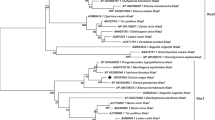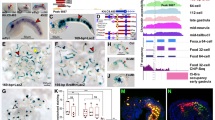Abstract
We have cloned and analysed the partial putative promoter sequences of the Yellowtail Kingfish (Seriola lalandi) Kiss2 and Kiss2r genes (380 and 420 bp, respectively). We obtained in silico 1.5 kb of the zebrafish (Danio rerio) Kiss1, Kiss2, Kiss1r and zfKiss2r sequences upstream of the putative transcriptional initiation site. Bioinformatic analysis revealed promoter regulatory elements including AP-1, Sp1, GR, ER, PR, AR, GATA-1, TTF-1, YY1 and C/EBP. These regulatory elements may mediate novel roles of the Kiss genes and their receptors in addition to their established role in reproductive function.


Similar content being viewed by others
References
Akazome Y, Kanda S, Okubo K, Oka Y (2010) Functional and evolutionary insights into vertebrate kisspeptin systems from studies of fish brain. J Fish Biol 76:161–182
Biran J, Ben-Dor S, Levavi-Sivan B (2008) Molecular identification and functional characterization of the kisspeptin/kisspeptin receptor system in lower vertebrates. Biol Reprod 79:776–786
Chan YM, Butler JP, Pinnel NE, Pralong FP, Crowley WF Jr, Ren C, Chan KK, Seminara SB (2011) Kisspeptin resets the hypothalamic GnRH clock in men. J Clin Endocrinol Metab 96:E908–E915
Clarke IJ, Smith JT, Caraty A, Goodman RL, Lehman NM (2009) Kisspeptin and seasonality in sheep. Peptides 30:154–163
de Roux N, Genin E, Carel JC, Matsuda F, Chaussain JL, Milgrom E (2003) Hypogonadotropic hypogonadism due to loss of function of the KiSS1-derive peptide receptor GPR54. PNAS 100:10972–10976
DeFino MC, Wacker JL, Lyssand JS, Wang EH, Hague C (2010) Differential regulation of GPR54 transcription by specificity protein-1 and partial estrogen response element in mouse pituitary cells. Biochem Biophys Res Commun 393:603–608
Felip A, Zanuy S, Pineda R, Pinilla L, Carrillo M, Tena-Sempere M, Gomez A (2009) Evidence for two distinct KiSS genes in non-placental vertebrates that encode kisspeptins with different gonadotropin-releasing activities in fish and mammals. Mol Cell Endocrinol 312:61–71
Kanda S, Akazome Y, Matsunaga T, Yamamoto N, Yamada S, Tsukamura H, Maeda K, Oka Y (2008) Identification of KiSS-1 product kisspeptin and steroid-sensitive 596 sexually dimorphic kisspeptin neurons in medaka (Oryzias latipes). Endocrinology 149:2467–2476
Kauffmann AS (2010) Coming of age in the kisspeptin era: sex differences, development, and puberty. Mol Cell Endocrinol 324:51–63
Kim TH, Barrera LO, Zheng M, Qu C, Sinher MA, Richmond TA, Wu Y, Green RD, Ren B (2005) A high-resolution map of active promoters in the human genome. Nature 436:876–880
Kim J, Semaan SS, Clifton DK, Steiner RA, Dhamija S, Kauffman SA (2011) Regulation of Kiss1 expression by sex steroids in the amygdala of the rat and mouse. Endocrinololy 152:2020–2030
Kim DK, Cho EB, Moon MJ, Park S, Hwang JI, Rego JLD, Vaudry H, Seong JY (2012) Molecular coevolution of neuropeptides gonadotropin-releasing hormone and kisspeptin with their cognate G protein-coupled receptors. Front Neurosci 6:1–8
Kinsey-Jones JS, Li XF, Knox MI, Wilkinson ES, Zhu XL, Chaudhary AA, Milligan SR, Lightman SL, O’Byrne KT (2009) Down-regulation of hypothalamic kisspeptin and its receptor, Kiss1r, mRNA expression is associated with stress-induced suppression of luteinising hormone secretion in the female rat. J Neuroendocrinol 21:20–29
Kitahashi T, Ogawa S, Parhar IS (2009) Cloning and expression of kiss2 in the zebrafish and medaka. Endocrinology 150:821–831
Kushner PJ, Agard DA, Greene GL, Scanlan TS, Shiau AK, Uht RM, Webb P (2000) Estrogen receptor pathways to AP-1. J Steroid Biochem Mol Biol 74:311–317
Lee JH, Miele ME, Hick DJ, Philips KK, Trent JM, Weissman BE, Welch DR (1996) KiSS-1, a novel human malignant melanoma metastasis-suppressor gene. J Natl Cancer Natl Cancer Inst 88:1731–1737
Löhr H, Hammerschmidt M (2011) Zebrafish in endocrine systems: recent advances and implications for human disease. Annu Rev Physiol 73:183–211
Mechaly AS, Viñas J, Piferrer F (2009) Identification of two isoforms of the kisspeptin-1 receptor (kiss1r) generated by alternative splicing in a modern teleost, the Senegalese sole (Solea senegalensis). Biol Reprod 80:60–69
Mechaly AS, Viñas J, Murphy C, Reith M, Piferrer F (2010) Gene structure of the Kiss1 receptor-2 (Kiss1r-2) in the Atlantic halibut: Insights into the evolution and regulation of Kiss1r genes. Mol Cell Endocrinol 317:78–89
Mechaly AS, Viñas J, Piferrer F (2011) Gene structure analysis of kisspeptin-2 (Kiss2) in the Senegalese sole (S. senegalensis): characterization of two splice variants of Kiss2, and novel evidence for metabolic regulation of kisspeptin signaling in non-mammalian species M. Mol Cell Endocrinol 339:14–24
Merika M, Orkin SH (1995) Functional synergy and physical interactions of the erythroid transcription factor GATA-1 with the Kruppel family proteins Sp1 and EKLF. Mol Cell Biol 15:2437–2447
Millar RP, Roseweir AK, Tello JA, Anderson RA, George JT, Morgan K, Pawson AJ (2010) Kisspeptin antagonists: unravelling the role of kisspeptin in reproductive physiology. Brain Res 1364:81–89
Mueller JK, Dietzel A, Lomniczi A, Loche A, Tefs K, Kiess W, Danne T, Ojeda SR, Heger S (2011) Transcriptional regulation of the human KiSS1 Gene. Mol Cell Endocrinol 342:8–19
Nocillado JN, Levavi-Sivan B, Carrick F, Elizur A (2007) Temporal expression of G-protein-coupled receptor 54 (GPR54), gonadotropin-releasing hormones (GnRH), and dopamine receptor D2 (drd2) in pubertal female grey mullet, Mugil cephalus. G. Gen Comp Endocrinol 150:278–287
Parhar IS, Ogawa S, Sakuma Y (2004) Laser-captured single digoxigenin-labeled neurons of gonadotropin-releasing hormone types reveal a novel G protein-coupled receptor (Gpr54) during maturation in cichlid fish. Endocrinology 145:3613–3618
Poortenaar CW, Hooker SH, Sharp N (2001) Assessment of yellowtail kingfish S. lalandi lalandi reproductive physiology, as a basis for aquaculture development. Aquaculture 20:271–286
Revel FG, Ansel L, Klosen P, Saboureau M, Pevet P, Mikkelson JD, Simmoneaux V (2007) Kisspeptin: a key link to seasonal breeding. Rev Endocr Metab Disord 8:57–65
Roth CL, Mastronardi C, Lomniczi A, Wright H, Cabrera R, Mungenast AE, Heger S, Jung H, Dubay C, Ojeda SR (2007) Expression of a tumor-related gene network increases in the mammalian hypothalamus at the time of female puberty. Endocrinology 148:5147–5161
Saville S, Wormke M, Wang F, Nguyen T, Enmark E, Kuiper G, Gustafsson JA, Safe S (2000) Ligand-, cell-, and estrogen receptor subtype (a/b)-dependent activation at GC-rich (Sp1) promoter elements. J Biol Chem 275:5379–5387
Sawyer I, Smillie SJ, Bodkin JV, Fernandes E, O’Byrne KT, Brain SD (2011) The vasoactive potential of kisspeptin-10 in the peripheral vasculature. PLoS ONE 6(2):e14671. doi:10.1371/journal.pone.0014671
Seminara SB, Messager S, Chatzidaki EE, Thresher RR, Acierno JS, Shagoury JK, Bo-Abbas Y, Kuohung W, Schwinof KM, Hendrick AG, Zahn D, Dixon J, Kaiser UB, Slaugenhaupt SA, Gusella JF, O’Rahilly S, Carlton MB, Crowley WF Jr, Aparicio SA, Colledge WH (2003) The GPR54 gene as a regulator of puberty. N Eng J Med 349:1614–1627
Servili A, Le Page Y, Leprince J, Caraty A, Escobar S, Parhar IS, Seong JY, Vaudry H, Kah O (2011) Organization of two independent kisspeptin systems derived from evolutionary-ancient Kiss genes in the brain of zebrafish. Endocrinology 152:1527–1540
Tena-Sempere M, Felip A, Gómez A, Zanuy S, Carrillo M (2012) Comparative insights of the kisspeptin/kisspeptin receptor system: lessons from non-mammalian vertebrates. Gen Comp Endocrinol 175:234–243
Wardle FC, Odom DT, Bell GW, Yuan B, Danford TW, Wiellette EL, Herbolsheimer E, Sive HL, Young RA, Smith JC (2006) Zebrafish promoter microarrays identify actively transcribed embryonic genes. Genome Biol 7:R71
Weger BD, Sahinbas M, Otto GW, Mracek P, Armant O, Dolle D, Lahiri K, Vallone D, Ettwiller L, Geisler R, Foulkes NS, Dickmeis T (2011) The light responsive transcriptome of the zebrafish: function and regulation. PLoS ONE 6:e17080
Acknowledgments
This project was funded by the Australian Seafood CRC (Project No. 2008/745), Fisheries Research and Development Corporation (FRDC) and the University of the Sunshine Coast. We thank Cleanseas Tuna Pty Ltd, South Australia, for providing the Yellowtail Kingfish tissue samples.
Author information
Authors and Affiliations
Corresponding author
Rights and permissions
About this article
Cite this article
Nocillado, J.N., Mechaly, A.S. & Elizur, A. In silico analysis of the regulatory region of the Yellowtail Kingfish and Zebrafish Kiss and Kiss receptor genes. Fish Physiol Biochem 39, 59–63 (2013). https://doi.org/10.1007/s10695-012-9642-0
Received:
Accepted:
Published:
Issue Date:
DOI: https://doi.org/10.1007/s10695-012-9642-0




